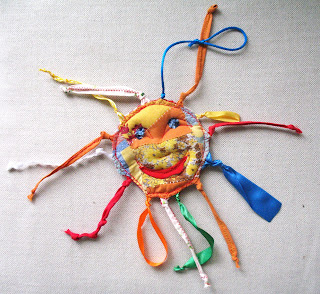Hello! Privet! Привет!
Do you have sometimes conflicts or at least tensions at home?
Well, I do (OK I am of an emotional type :).
I doubt if you do not, but if this is luckily a case, please share with us your secret!
For those who do have, there is a small remedy amongst Russian Traditional Dolls. It is called The Purification Doll - Очистительная Кукла. I call it also The Peace of the House Doll.
As the name suggests, it is used to clean the house from the negative energies after any conflicts or at any household tensions. When nobody is around, the housewife would open the windows or the doors, would take out her Purification Doll and would brush away negative energies using the doll as a broom.
From my own experience I can tell that once you start using this doll, the tensions and disputes reduce and become more controllable. I bet that psychologists will find professional explanation to this fact. My common sense tells that if you simply want to have peace in your house, this small ritual reinforces your wish, works like an anchor for it. Also, by removing your mistake (the conflict) you put yourself into a positive mindset.
One of few traditional dolls, the Purification Doll has human-like body with a head, hands, legs and breasts. This makes it a kids favourite during my fairs. Kids can play with this doll, and if explained on its purpose, they can learn to manage their small disagreements themselves.
Finally, for a small pub, you can find my Kit for Purification Doll on DaWanda :)
Yours
Kukliki
Do you have sometimes conflicts or at least tensions at home?
Well, I do (OK I am of an emotional type :).
I doubt if you do not, but if this is luckily a case, please share with us your secret!
For those who do have, there is a small remedy amongst Russian Traditional Dolls. It is called The Purification Doll - Очистительная Кукла. I call it also The Peace of the House Doll.
As the name suggests, it is used to clean the house from the negative energies after any conflicts or at any household tensions. When nobody is around, the housewife would open the windows or the doors, would take out her Purification Doll and would brush away negative energies using the doll as a broom.
From my own experience I can tell that once you start using this doll, the tensions and disputes reduce and become more controllable. I bet that psychologists will find professional explanation to this fact. My common sense tells that if you simply want to have peace in your house, this small ritual reinforces your wish, works like an anchor for it. Also, by removing your mistake (the conflict) you put yourself into a positive mindset.
One of few traditional dolls, the Purification Doll has human-like body with a head, hands, legs and breasts. This makes it a kids favourite during my fairs. Kids can play with this doll, and if explained on its purpose, they can learn to manage their small disagreements themselves.
Finally, for a small pub, you can find my Kit for Purification Doll on DaWanda :)
Yours
Kukliki










